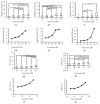Disturbances in Electrodermal Activity Recordings Due to Different Noises in the Environment
- PMID: 39205128
- PMCID: PMC11359885
- DOI: 10.3390/s24165434
Disturbances in Electrodermal Activity Recordings Due to Different Noises in the Environment
Abstract
Electrodermal activity (EDA) is a widely used psychophysiological measurement in laboratory-based studies. In recent times, these measurements have seen a transfer from the laboratory to wearable devices due to the simplicity of EDA measurement as well as modern electronics. However, proper conditions for EDA measurement are recommended once wearable devices are used, and the ambient conditions may influence such measurements. It is not completely known how different types of ambient noise impact EDA measurement and how this translates to wearable EDA measurement. Therefore, this study explored the effects of various noise disturbances on the generation of EDA responses using a system for the simultaneous recording of all measures of EDA, i.e., skin conductance responses (SCRs), skin susceptance responses (SSRs), and skin potential responses (SPRs), at the same skin site. The SCRs, SSRs, and SPRs due to five types of noise stimuli at different sound pressure levels (70, 75, 80, 85, and 90 dB) were measured from 40 participants. The obtained results showed that EDA responses were generated at all levels and that the EDA response magnitudes were significantly (p < 0.001) influenced by the increasing noise levels. Different types of environmental noise may elicit EDA responses and influence wearable recordings outside the laboratory, where such noises are more likely than in standardized laboratory tests. Depending on the application, it is recommended to prevent these types of unwanted variation, presenting a challenge for the quality of wearable EDA measurement in real-world conditions. Future developments to shorten the quality gap between standardized laboratory-based and wearable EDA measurements may include adding microphone sensors and algorithms to detect, classify, and process the noise-related EDA.
Keywords: electrodermal activity; electrodermal responses; noise; skin; sweat; wearable.
Conflict of interest statement
The authors declare no conflicts of interest.
Figures




References
-
- Boucsein W. Electrodermal Activity. Springer Science & Business Media; New York, NY, USA: 2012.
-
- Masullo M., Toma R.A., Maffei L. Effects of Industrial Noise on Physiological Responses. Acoustics. 2022;4:733–745. doi: 10.3390/acoustics4030044. - DOI
-
- Malathi D., Jayaseeli J.D., Madhuri S., Senthilkumar K. Electrodermal activity based wearable device for drowsy drivers. J. Phys. Conf. Ser. 2018;1000:012048. doi: 10.1088/1742-6596/1000/1/012048. - DOI
-
- Leite I., Henriques R., Martinho C., Paiva A. Sensors in the wild: Exploring electrodermal activity in child-robot interaction; Proceedings of the 2013 8th ACM/IEEE International Conference on Human-Robot Interaction (HRI); Tokyo, Japan. 3–6 March 2013.
-
- Kim J., Fesenmaier D.R. Measuring emotions in real time: Implications for tourism experience design. J. Travel Res. 2015;54:419–429. doi: 10.1177/0047287514550100. - DOI
MeSH terms
LinkOut - more resources
Full Text Sources
Medical
Miscellaneous

